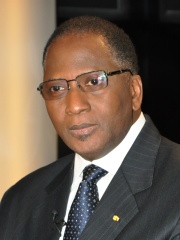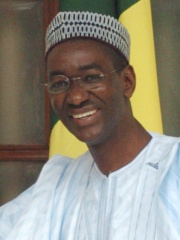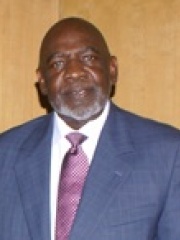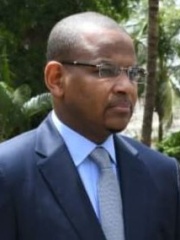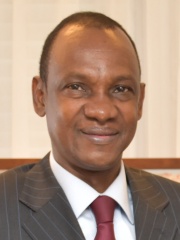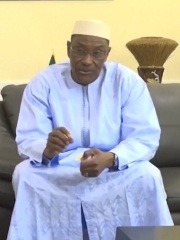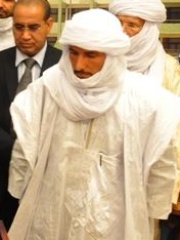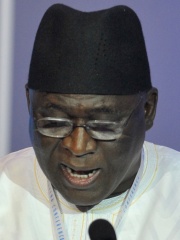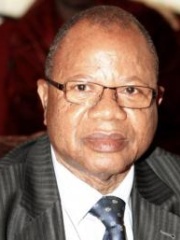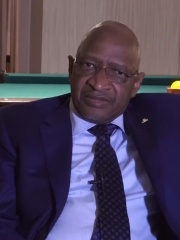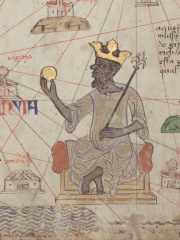
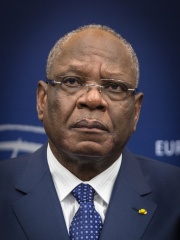
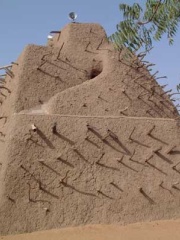
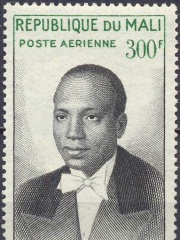
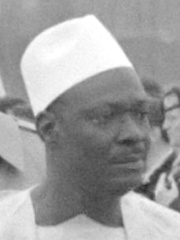
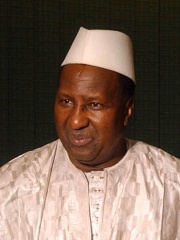
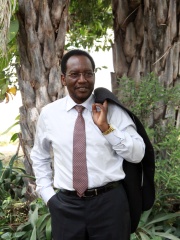
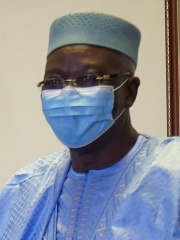
The Most Famous
POLITICIANS from Mali
This page contains a list of the greatest Malian Politicians. The pantheon dataset contains 19,576 Politicians, 26 of which were born in Mali. This makes Mali the birth place of the 100th most number of Politicians behind Bangladesh, and Malta.
Top 10
The following people are considered by Pantheon to be the top 10 most legendary Malian Politicians of all time. This list of famous Malian Politicians is sorted by HPI (Historical Popularity Index), a metric that aggregates information on a biography's online popularity. Visit the rankings page to view the entire list of Malian Politicians.

1. Musa I of Mali (1280 - 1337)
With an HPI of 87.24, Musa I of Mali is the most famous Malian Politician. His biography has been translated into 70 different languages on wikipedia.
Mansa Musa (reigned c. 1312 – c. 1337) was the ninth Mansa of the Mali Empire, which reached its territorial peak during his reign. Musa's reign is often regarded as the zenith of Mali's power and prestige, although he features less in Mandinka oral traditions than his predecessors. Musa was exceptionally wealthy, to an extent that contemporaries described him as inconceivably rich; Time magazine reported: "There's really no way to put an accurate number on his wealth." It is known from local manuscripts and travellers' accounts that Mansa Musa's wealth came principally from the Mali Empire's control and taxing of the trade in salt from northern regions and especially from gold panned and mined in Bambuk and Bure to the south. Over a very long period Mali had amassed a large reserve of gold. Mali is also believed to have been involved in the trade in many goods such as ivory, slaves, spices, silks, and ceramics. However, presently little is known about the extent or mechanics of these trades. At the time of Musa's ascension to the throne, Mali consisted largely of the territory of the former Ghana Empire, which had become a vassal of Mali. The Mali Empire comprised land that is now part of Guinea, Senegal, Mauritania, the Gambia, and the modern state of Mali. Musa went on Hajj to Mecca in 1324, traveling with an enormous entourage and a vast supply of gold. En route he spent time in Cairo, where his lavish gift-giving is said to have noticeably affected the value of gold in Egypt and garnered the attention of the wider Muslim world. Musa expanded the borders of the Mali Empire, in particular incorporating the cities of Gao and Timbuktu into its territory. He sought closer ties with the rest of the Muslim world, particularly the Mamluk and Marinid Sultanates. He recruited scholars from the wider Muslim world to travel to Mali, such as the Andalusian poet Abu Ishaq al-Sahili, and helped establish Timbuktu as a center of Islamic learning. His reign is associated with numerous construction projects, including a portion of Djinguereber Mosque in Timbuktu.

2. Ibrahim Boubacar Keïta (1945 - 2022)
With an HPI of 69.68, Ibrahim Boubacar Keïta is the 2nd most famous Malian Politician. His biography has been translated into 59 different languages.
Ibrahim Boubacar Keïta (French: [ibʁa.im bubakaʁ ke.ita]; 29 January 1945 – 16 January 2022), often known by his initials IBK, was a Malian politician who served as the president of Mali from September 2013 to August 2020, when he was forced to resign in the 2020 Malian coup d'état. He served as Mali's prime minister from February 1994 to February 2000 and as president of the National Assembly of Mali from September 2002 to September 2007. Keïta founded the centre-left political party Rally for Mali (RPM) in 2001. After a number of unsuccessful campaigns, he was elected president in the 2013 presidential election and reelected in 2018. He was deposed by mutinous elements of the Malian Armed Forces on 18 August 2020 and officially resigned the following day.

3. Askia Mohammad I (1443 - 1538)
With an HPI of 69.46, Askia Mohammad I is the 3rd most famous Malian Politician. His biography has been translated into 32 different languages.
Askia Muhammad Ture I (1443–1538), born Muhammad ibn Abi Bakr al-Turi or Muhammad Ture, was the first ruler of the Askia dynasty of the Songhai Empire, reigning from 1493 to 1528. He is also known as Askia the Great, and his name in modern Songhai is Mamar Kassey. Askia Muhammad strengthened his empire and made it the largest empire in West Africa's history. At its peak under his reign, the Songhai Empire encompassed the Hausa states as far as Kano (in present-day Northern Nigeria) and much of the territory that had belonged to the Songhai empire in the east. His policies resulted in a rapid expansion of trade with Europe and Asia, the creation of many schools, and the establishment of Islam as an integral part of the empire. Muhammad was a prominent general under the Songhai ruler Sunni Ali. When Sunni Ali was succeeded by his son, Sunni Baru, in 1492, Muhammad challenged the succession on the grounds that the new ruler was not a faithful Muslim. He defeated Baru and ascended to the throne in 1493. Ture subsequently orchestrated a program of expansion and consolidation which extended the empire from Taghaza in the North to the borders of Yatenga in the South; and from Air in the Northeast to Futa Djallon in Guinea. Instead of organizing the empire along Islamic lines, he tempered and improved on the traditional model by instituting a system of bureaucratic government unparalleled in Western Africa. In addition, Askia established standardized trade measures and regulations, initiated the policing of trade routes and also established an organized tax system. He was overthrown by his son, Askia Musa, in 1528.

4. Modibo Keïta (1915 - 1977)
With an HPI of 68.35, Modibo Keïta is the 4th most famous Malian Politician. His biography has been translated into 46 different languages.
Modibo Keïta (4 June 1915 – 16 May 1977) was a Malian politician who served as the first President of Mali from 1960 to 1968. He espoused a form of African socialism. He was deposed in a coup d'état in 1968 by Moussa Traoré. Born and raised in Bamako, Keïta began a career as a teacher in 1936 under French colonial rule before entering politics during the 1940s. In 1945, he co-founded the Sudanese Union (US) with Mamadou Konaté which became part of the African Democratic Rally (RDA) the following year to form the US-RDA. Being elected to several positions, his political prominence grew in the 1950s, and in 1959, he became Prime Minister of the Mali Federation, a short-lived federation of Mali and Senegal. Following the federation's collapse in 1960, Mali became an independent state, and Keïta became the new country's inaugural president. As President, Keïta soon established the US-RDA as the only official party, and began implementing socialist policies based on extensive nationalization. In foreign affairs, Keïta supported the Non-Aligned Movement and maintained strong relations with the West despite his socialist leanings. A leading Pan-Africanist, he played important roles in the drafting of the charter of the Organization of African Unity and the negotiation the 1963 Bamako Accords, which ended the Sand War between Morocco and Algeria. During the late 1960s, dissatisfaction with his regime grew due to progressive economic decline and his repressive responses to dissent. He was overthrown in the 1968 Malian coup d'état by Moussa Traoré, who succeeded him as president and sent him to prison, where he died in 1977.
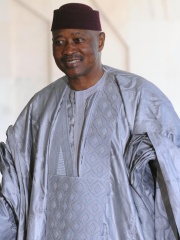
5. Amadou Toumani Touré (1948 - 2020)
With an HPI of 68.08, Amadou Toumani Touré is the 5th most famous Malian Politician. His biography has been translated into 59 different languages.
Amadou Toumani Touré (4 November 1948 – 9 November 2020), also popularly known by his initials ATT (French pronunciation: [atete]), was a Malian politician and military officer who served as Mali's head of state twice, from 1991 to 1992 as acting president and again as a democratically elected president from 2002 until he was deposed in a coup in 2012. Touré was head of President Moussa Traoré's personal guard (and parachute regiment) when a popular revolution and a coup overthrew the regime in March 1991. Touré then arrested Traoré and led the revolution onward. He presided over a year-long military-civilian transition process that produced a new Constitution and multiparty elections, then handed power to Mali's first democratically elected president, Alpha Oumar Konaré, on 8 June 1992. Konaré promoted Touré to the rank of General. Ten years later, after retiring from the army, Touré entered politics as a civilian and won the 2002 presidential election with a broad coalition of support. He was easily re-elected in 2007 to a second and final term. On 22 March 2012, shortly before his scheduled departure from office, disgruntled soldiers initiated a coup d'état that forced him into hiding. As part of the agreement to restore constitutional order to Mali, Touré resigned from the presidency on 8 April, and eleven days later he went into exile.

6. Moussa Traoré (1936 - 2020)
With an HPI of 66.87, Moussa Traoré is the 6th most famous Malian Politician. His biography has been translated into 44 different languages.
Moussa Traoré (25 September 1936 – 15 September 2020) was a Malian military officer, politician, and dictator who served as the second President of Mali from 1968 to 1991. As a lieutenant, he led the military ousting of President Modibo Keïta in 1968. Thereafter he served as head of state until March 1991, when he was overthrown by popular protests and a military coup. During his tenure, political activity was banned, marking a shift to authoritarian control. His right-hand man Tiécoro Bagayoko oversaw a regime of surveillance with the help of informants. He dismantled the socialist economic policies of his predecessor, Modibo Keïta. He was twice condemned to death in the 1990s, but eventually pardoned on both occasions and freed in 2002. He retired from public life and died in 2020.

7. Alpha Oumar Konaré (b. 1946)
With an HPI of 64.78, Alpha Oumar Konaré is the 7th most famous Malian Politician. His biography has been translated into 42 different languages.
Alpha Oumar Konaré (born 2 February 1946) is a Malian politician, professor, historian and archaeologist, who served as President of Mali for two five-year terms from 1992 to 2002 and was Chairperson of the African Union Commission from 2003 to 2008.

8. Dioncounda Traoré (b. 1942)
With an HPI of 62.00, Dioncounda Traoré is the 8th most famous Malian Politician. His biography has been translated into 30 different languages.
Dioncounda Traoré (born 23 February 1942) is a Malian politician who was President of Mali in an interim capacity from April 2012 to September 2013. Previously he was President of the National Assembly of Mali from 2007 to 2012, and he served as Minister of Foreign Affairs from 1994 to 1997. He was President of the Alliance for Democracy in Mali-African Party for Solidarity and Justice (ADEMA-PASJ) beginning in 2000, and he was also President of the Alliance for Democracy and Progress (ADP), an alliance of parties that supported the re-election of President Amadou Toumani Touré in 2007.

9. Bah Ndaw (b. 1950)
With an HPI of 61.55, Bah Ndaw is the 9th most famous Malian Politician. His biography has been translated into 29 different languages.
Bah Ndaw (also spelled N'Daw, N'Dah, and N'Daou; born 23 August 1950) is a Malian retired military officer and politician who served as the interim president of Mali from 2020 to 2021, when he was deposed in a coup. He previously served as the Minister of Defense and Veterans Affairs in the government of President Ibrahim Boubacar Keïta from 2014 to 2015.

10. Sonni Ali (1464 - 1492)
With an HPI of 61.41, Sonni Ali is the 10th most famous Malian Politician. His biography has been translated into 25 different languages.
Sonni Ali, also known as Si Ali, Sonni Ali Ber (Ber meaning "the Great"), reigned from about 1464 to 1492 as the 15th ruler of the Sunni dynasty of the Songhai Empire. He transformed the relatively small state into an empire by conquering Timbuktu, Massina, the Inner Niger Delta, and Djenne.
People
Pantheon has 26 people classified as Malian politicians born between 1280 and 1983. Of these 26, 13 (50.00%) of them are still alive today. The most famous living Malian politicians include Alpha Oumar Konaré, Dioncounda Traoré, and Bah Ndaw. The most famous deceased Malian politicians include Musa I of Mali, Ibrahim Boubacar Keïta, and Askia Mohammad I.
Living Malian Politicians
Go to all RankingsAlpha Oumar Konaré
1946 - Present
HPI: 64.78
Dioncounda Traoré
1942 - Present
HPI: 62.00
Bah Ndaw
1950 - Present
HPI: 61.55
Modibo Sidibé
1952 - Present
HPI: 54.26
Moctar Ouane
1955 - Present
HPI: 54.12
Assimi Goïta
1983 - Present
HPI: 54.05
Cheick Modibo Diarra
1952 - Present
HPI: 52.94
Boubou Cissé
1974 - Present
HPI: 52.61
Choguel Kokalla Maïga
1958 - Present
HPI: 51.53
Amadou Sanogo
1972 - Present
HPI: 50.92
Abdoulaye Idrissa Maïga
1958 - Present
HPI: 50.00
Bilal Ag Acherif
1977 - Present
HPI: 47.22
Deceased Malian Politicians
Go to all RankingsMusa I of Mali
1280 - 1337
HPI: 87.24
Ibrahim Boubacar Keïta
1945 - 2022
HPI: 69.68
Askia Mohammad I
1443 - 1538
HPI: 69.46
Modibo Keïta
1915 - 1977
HPI: 68.35
Amadou Toumani Touré
1948 - 2020
HPI: 68.08
Moussa Traoré
1936 - 2020
HPI: 66.87
Sonni Ali
1464 - 1492
HPI: 61.41
Modibo Keita
1942 - 2021
HPI: 58.97
Cissé Mariam Kaïdama Sidibé
1948 - 2021
HPI: 54.40
Django Sissoko
1948 - 2022
HPI: 52.77
Ousmane Issoufi Maïga
1945 - Present
HPI: 52.26
Soumeylou Boubèye Maïga
1954 - 2022
HPI: 52.14
Overlapping Lives
Which Politicians were alive at the same time? This visualization shows the lifespans of the 9 most globally memorable Politicians since 1700.

